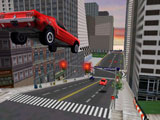 Two years ago, Microsoft released Midtown Madness, a solid
arcade racer that wasn’t quite enough of either for our tastes. It just didn’t
have enough wacky fun in it to be an arcade game like, say, Speedbusters, and it wasn’t
realistic enough to be a racing sim. It didn’t help any that the game was a little
short--or that it was set in Chicago. Now, don’t get me wrong—I love Chicago,
but it’s just not the most architecturally intriguing city in the world, and the
racing suffered for it. Midtown Madness 2 does a good job of addressing these problems—first
of all, it’s a much larger game, with two terrific settings—London and San
Francisco, both of which are much more interesting (at least for racing) than Chicago. In
fact, one of the reasons we like MM2 so much better than its original is because London
and San Francisco offer much more potential for over-the-top motoring mayhem than the
Windy City. For instance, in MM2 you’ll find yourself racing through the London tube
system, splashing through the Serpentine in Hyde Park, and launching your ride down
Lombard Street. The narrow streets and
circuses of London and the hills of San Francisco challenge you in ways that the Dan Ryan
just can’t. Two years ago, Microsoft released Midtown Madness, a solid
arcade racer that wasn’t quite enough of either for our tastes. It just didn’t
have enough wacky fun in it to be an arcade game like, say, Speedbusters, and it wasn’t
realistic enough to be a racing sim. It didn’t help any that the game was a little
short--or that it was set in Chicago. Now, don’t get me wrong—I love Chicago,
but it’s just not the most architecturally intriguing city in the world, and the
racing suffered for it. Midtown Madness 2 does a good job of addressing these problems—first
of all, it’s a much larger game, with two terrific settings—London and San
Francisco, both of which are much more interesting (at least for racing) than Chicago. In
fact, one of the reasons we like MM2 so much better than its original is because London
and San Francisco offer much more potential for over-the-top motoring mayhem than the
Windy City. For instance, in MM2 you’ll find yourself racing through the London tube
system, splashing through the Serpentine in Hyde Park, and launching your ride down
Lombard Street. The narrow streets and
circuses of London and the hills of San Francisco challenge you in ways that the Dan Ryan
just can’t.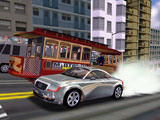 As in Midtown Madness,
you can choose from three kinds of races—Blitz, Circuit, and Checkpoint. Blitz races
pit you against the clock as you wend your way through the city, Checkpoint races pit you
against other drivers, and in Circuit races you’ll race through cordoned-off courses
against some very aggressive opponents. As you successfully complete races, you’ll
unlike ever-more formidable cars and flashier paint jobs. Don’t expect too much
realism—though different cars handle differently, the emphasis in MM2 is on action.
You’re able to hurtle over the hills of San Francisco like McQueen in Bullit, crash
with relative impunity into other cars and buildings, run through department store show
windows for shortcuts, and generally wreak havoc on the traffic code. Microsoft has also
added a new “crash course” feature, a series of mission-based races in which you
take the role of a California stunt driver or a London cabbie. These races are challenging
and interesting, and are intended to serve as a sort of tutorial. Initially, you’ll
be requested to complete missions that require you to master basic skills—turning,
using the handbrake, controlling a skid—but as the courses progress, you’ll find
yourself performing stunts right out of movies. And of course if you just want to kick back and see the sights, you can
choose to race in cruise mode, which allows you drive around and scout the routes at your
leisure. One suggestion, though; in cruise
mode, it seems like every cop in town has a vendetta against you. Make sure you turn cop
density way down unless you wish to be pulled over (that is, run into) incessantly. As in Midtown Madness,
you can choose from three kinds of races—Blitz, Circuit, and Checkpoint. Blitz races
pit you against the clock as you wend your way through the city, Checkpoint races pit you
against other drivers, and in Circuit races you’ll race through cordoned-off courses
against some very aggressive opponents. As you successfully complete races, you’ll
unlike ever-more formidable cars and flashier paint jobs. Don’t expect too much
realism—though different cars handle differently, the emphasis in MM2 is on action.
You’re able to hurtle over the hills of San Francisco like McQueen in Bullit, crash
with relative impunity into other cars and buildings, run through department store show
windows for shortcuts, and generally wreak havoc on the traffic code. Microsoft has also
added a new “crash course” feature, a series of mission-based races in which you
take the role of a California stunt driver or a London cabbie. These races are challenging
and interesting, and are intended to serve as a sort of tutorial. Initially, you’ll
be requested to complete missions that require you to master basic skills—turning,
using the handbrake, controlling a skid—but as the courses progress, you’ll find
yourself performing stunts right out of movies. And of course if you just want to kick back and see the sights, you can
choose to race in cruise mode, which allows you drive around and scout the routes at your
leisure. One suggestion, though; in cruise
mode, it seems like every cop in town has a vendetta against you. Make sure you turn cop
density way down unless you wish to be pulled over (that is, run into) incessantly.
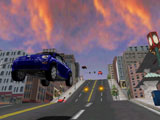 Though the car models don’t look all that much different
than those in Midtown Madness, the environments look much better. Too much of the original
was made up of nondescript buildings interspersed with the occasional landmark. (Look,
there’s the water tower! Look, there’s eighteen blocks of warehouses!). Midtown
Madness goes out of its way to make you feel like you’re in San Francisco and London,
even when you’re not in Trafalgar Square or crossing the Golden Gate. Of course it
helps that each of these cities has a distinctive style, but it’s clear that
Microsoft put more time into modeling these cities, and it pays off. While not state-of-the-art, the graphics are
generally good and sometimes spectacular (sunset and fog effects are particularly
excellent). There are occasional clipping problems, though, and I once or twice found
myself driving through a wall and into graphics hell. And one should be warned that while
the graphics look very nice, it takes a big machine to run this game smoothly. Expect some
chop even with the recommended configuration. Though the car models don’t look all that much different
than those in Midtown Madness, the environments look much better. Too much of the original
was made up of nondescript buildings interspersed with the occasional landmark. (Look,
there’s the water tower! Look, there’s eighteen blocks of warehouses!). Midtown
Madness goes out of its way to make you feel like you’re in San Francisco and London,
even when you’re not in Trafalgar Square or crossing the Golden Gate. Of course it
helps that each of these cities has a distinctive style, but it’s clear that
Microsoft put more time into modeling these cities, and it pays off. While not state-of-the-art, the graphics are
generally good and sometimes spectacular (sunset and fog effects are particularly
excellent). There are occasional clipping problems, though, and I once or twice found
myself driving through a wall and into graphics hell. And one should be warned that while
the graphics look very nice, it takes a big machine to run this game smoothly. Expect some
chop even with the recommended configuration.
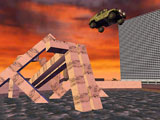 As for vehicles, MM2 includes all of your favorites from the
original and nine new cars. In keeping with the London theme, you’ll be able to drive
the Mini Cooper (useless) a London double-decker bus (useless but fun) and the
Aston-Martin DB-7 (awesome but takes a while to unlock). The other new cars include two
kinds of VW beetles, a fire truck, the Audi TT (personal favorite) and a Light Tactical
Vehicle (a Humvee). As the game constantly reminds you, you have to make sure you pick the
right car for the right race. Courses that take you over San Francisco’s steeper
hills will call for a car that can take some damage, and races through the narrow lanes of
London place a premium upon handling, though I must admit that once I unlocked the Audi I
never looked back. Fire trucks and double-decker buses won’t win you many races, but
they’re fun to tool around in. As for vehicles, MM2 includes all of your favorites from the
original and nine new cars. In keeping with the London theme, you’ll be able to drive
the Mini Cooper (useless) a London double-decker bus (useless but fun) and the
Aston-Martin DB-7 (awesome but takes a while to unlock). The other new cars include two
kinds of VW beetles, a fire truck, the Audi TT (personal favorite) and a Light Tactical
Vehicle (a Humvee). As the game constantly reminds you, you have to make sure you pick the
right car for the right race. Courses that take you over San Francisco’s steeper
hills will call for a car that can take some damage, and races through the narrow lanes of
London place a premium upon handling, though I must admit that once I unlocked the Audi I
never looked back. Fire trucks and double-decker buses won’t win you many races, but
they’re fun to tool around in.
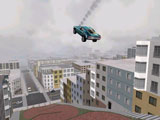 Though I usually don’t pay much attention to sound, it’s
worth commenting about it MM2 for several reasons. First, the engine, skid, and collision
sound effects are very watered-down. I mean, it’s as if someone said, OK, we went way
over the top with physics models and collisions, so let’s even it out by toning the
sound way down. Big mistake; this is the kind of game that cries out for excessive
sound effects (and a kick-ass sound track; given the musical backgrounds of both these
cities, I’m surprised that the music in the game is so nondescript). Secondly, during
most of the races—usually at the beginning and end—you’ll hear some
voice-over comment about the race. The London ones are pretty good, or at least
inoffensive, but the San Francisco commentators include a stock flower child voice that
just sucks and is like, so thirty years ago that you have to wonder if whoever’s in
charge of sound has even been to the city since 1968. Though I usually don’t pay much attention to sound, it’s
worth commenting about it MM2 for several reasons. First, the engine, skid, and collision
sound effects are very watered-down. I mean, it’s as if someone said, OK, we went way
over the top with physics models and collisions, so let’s even it out by toning the
sound way down. Big mistake; this is the kind of game that cries out for excessive
sound effects (and a kick-ass sound track; given the musical backgrounds of both these
cities, I’m surprised that the music in the game is so nondescript). Secondly, during
most of the races—usually at the beginning and end—you’ll hear some
voice-over comment about the race. The London ones are pretty good, or at least
inoffensive, but the San Francisco commentators include a stock flower child voice that
just sucks and is like, so thirty years ago that you have to wonder if whoever’s in
charge of sound has even been to the city since 1968.
Finally, though the cars usually
drive pretty consistently, there can be some problems with control, especially since don’t
have much choice in how you can configure your controller. I also had problems getting
force feedback to work consistently. Sometimes it would, sometimes it wouldn’t.
Overall, this is
a solid, fun effort. Multiplayer is very good, and with two cities and the added crash
course feature, MM2 is a marked improvement over Midtown Madness.
--Rick
Fehrenbacher |

 Two years ago, Microsoft released Midtown Madness, a solid
arcade racer that wasn’t quite enough of either for our tastes. It just didn’t
have enough wacky fun in it to be an arcade game like, say, Speedbusters, and it wasn’t
realistic enough to be a racing sim. It didn’t help any that the game was a little
short--or that it was set in Chicago. Now, don’t get me wrong—I love Chicago,
but it’s just not the most architecturally intriguing city in the world, and the
racing suffered for it. Midtown Madness 2 does a good job of addressing these problems—first
of all, it’s a much larger game, with two terrific settings—London and San
Francisco, both of which are much more interesting (at least for racing) than Chicago. In
fact, one of the reasons we like MM2 so much better than its original is because London
and San Francisco offer much more potential for over-the-top motoring mayhem than the
Windy City. For instance, in MM2 you’ll find yourself racing through the London tube
system, splashing through the Serpentine in Hyde Park, and launching your ride down
Lombard Street. The narrow streets and
circuses of London and the hills of San Francisco challenge you in ways that the Dan Ryan
just can’t.
Two years ago, Microsoft released Midtown Madness, a solid
arcade racer that wasn’t quite enough of either for our tastes. It just didn’t
have enough wacky fun in it to be an arcade game like, say, Speedbusters, and it wasn’t
realistic enough to be a racing sim. It didn’t help any that the game was a little
short--or that it was set in Chicago. Now, don’t get me wrong—I love Chicago,
but it’s just not the most architecturally intriguing city in the world, and the
racing suffered for it. Midtown Madness 2 does a good job of addressing these problems—first
of all, it’s a much larger game, with two terrific settings—London and San
Francisco, both of which are much more interesting (at least for racing) than Chicago. In
fact, one of the reasons we like MM2 so much better than its original is because London
and San Francisco offer much more potential for over-the-top motoring mayhem than the
Windy City. For instance, in MM2 you’ll find yourself racing through the London tube
system, splashing through the Serpentine in Hyde Park, and launching your ride down
Lombard Street. The narrow streets and
circuses of London and the hills of San Francisco challenge you in ways that the Dan Ryan
just can’t.